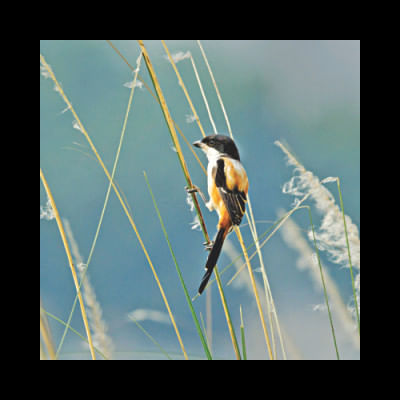Our Shrikes

The other day I was walking on a field in Purbachol when I noticed a bird perched on the stalk of a shrivelled kash flower. Coming closer, I noticed its distinctive black cap, hooked beak and somewhat aggressive stance. At only nine or ten inches it had the attitude of something much larger. It was definitely checking me out, but decided I was too big a prey. Presently it switched its attention to something more manageable near the ground and eventually went into a sharp dive before flying off. I couldn't see if it had caught anything.
It was the first time I had watched a long-tailed shrike for more than a few seconds. The shrike family of birds, called Laniidae, comprises of 31 species. "Laniidae" comes from the Latin meaning "butcher," and shrikes are called butcher birds or koshai pakhi in Bangla. That's because they impale their prey on thorns or anything sharp, much like a butcher hangs a carcass. They then cut up the prey and eat it at their convenience. Some shrikes hunt large preys – small birds or mammals for example – and cache the carcass for times of scarcity.
In Bangladesh seven species of shrikes have been sighted. Of these, three species are fairly common.
The long-tailed shrike, our most common shrike, is a sleek, handsome bird with a black cap, long black tail, and a orange-yellow body with a white underpart. At 25 centimetres long it weighs 45 grams. It feeds on small insects such as locusts, grasshoppers, crickets, lizards, small rodents and other insects, searching the ground for them while perched high on a stalk of grass or branch. It lives here all year (instead of migrating.) Basically a solitary creature, it builds a cup-shaped nest and breeds from December to July. Its global range extends from Pakistan through the Philippines. You can often see it perched on electrical wires in the countryside.
Our other commonly seen shrike is the brown shrike which is a winter visitor from northern Asiatic lands such as Siberia and Mongolia. It can be found in open woodlands and scrubs, riverbanks, smaller trees and dried haors. It is a smaller bird at 19 centimetres and 28 grams. While not as striking in appearance as its long-tailed cousin, it has a bold black bar like a mask over its eyes. Its diet is similar to the long-tailed shrike. I have seen it in Savar and the Botanical Garden in Mirpur as well as in rural areas.
The third shrike you can see in Bangladesh – though not quite as easily as the two above – is the grey-backed shrike. It is a winter visitor and can be found in environments similar to the other two. A fourth shrike, the bay-backed shrike, was thought to have been extirpated from Bangladesh. However, it was spotted last year in Chittagong.
Among other shrikes worldwide, the northern shrike, known for hunting smaller birds and mammals, breeds in tundras and taigas of the far north and spends its winters in North America. However, most members of the shrike family live in Eurasia and Africa.
www.facebook.com/tangents.ikabir.

 For all latest news, follow The Daily Star's Google News channel.
For all latest news, follow The Daily Star's Google News channel. 



Comments